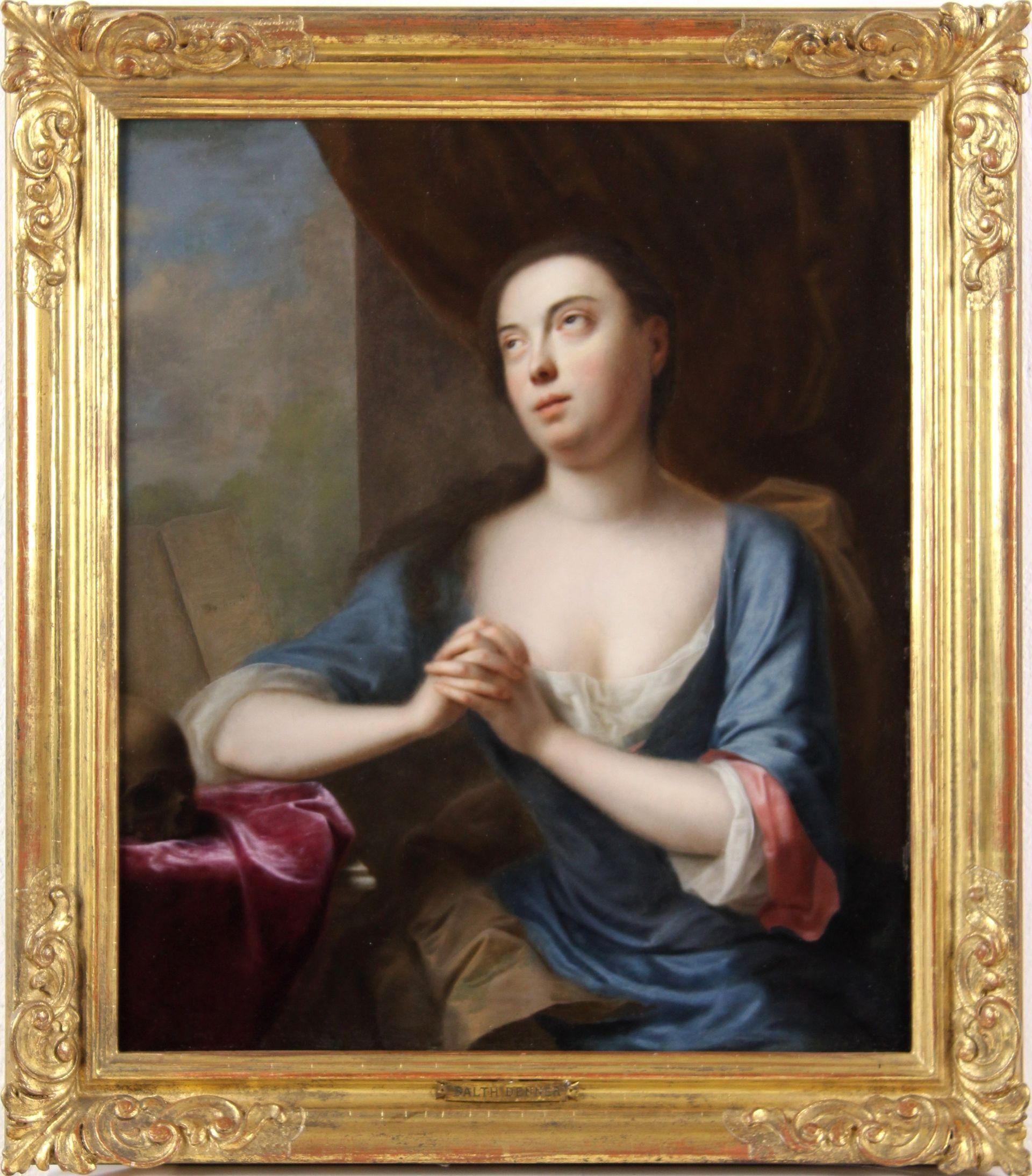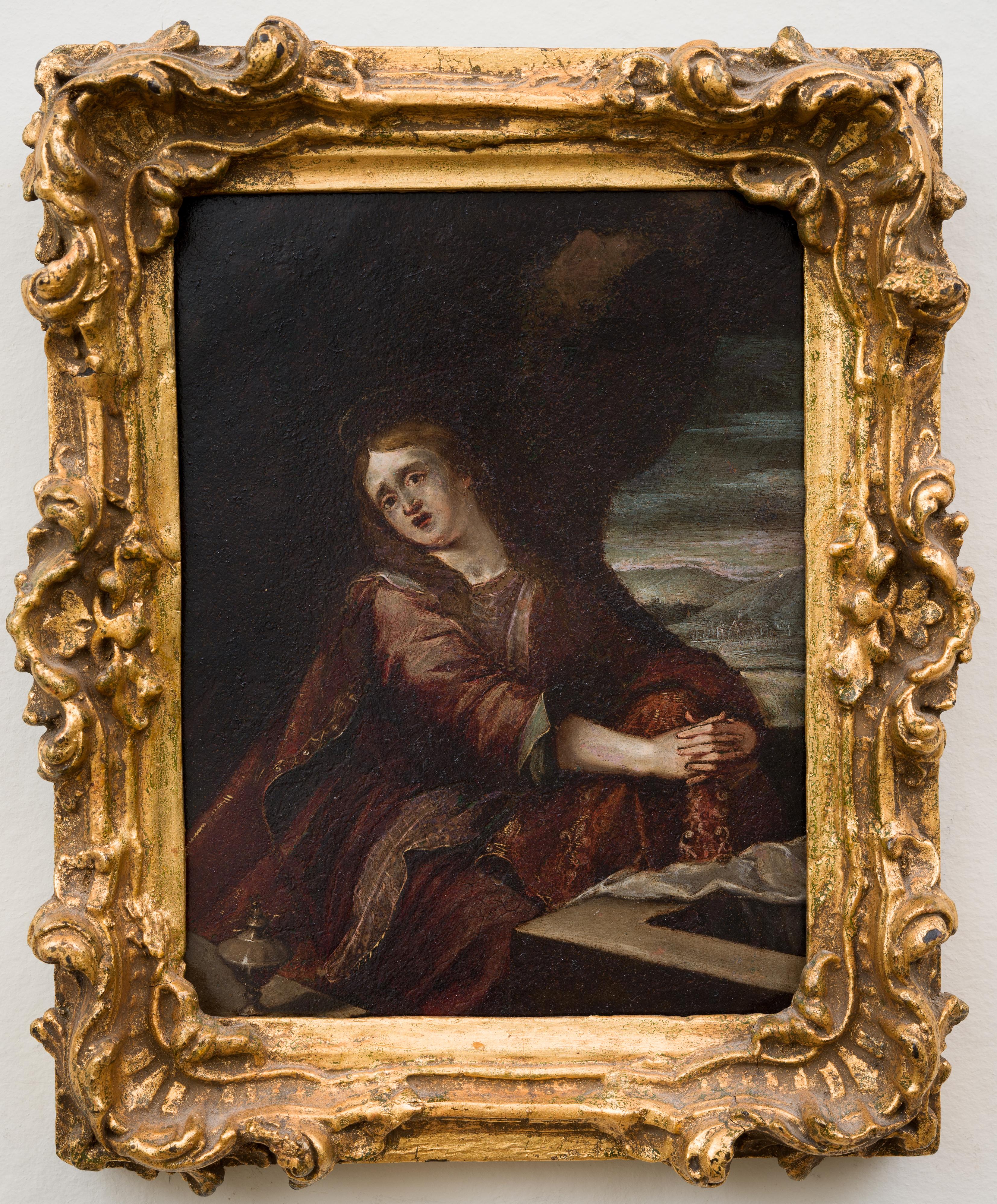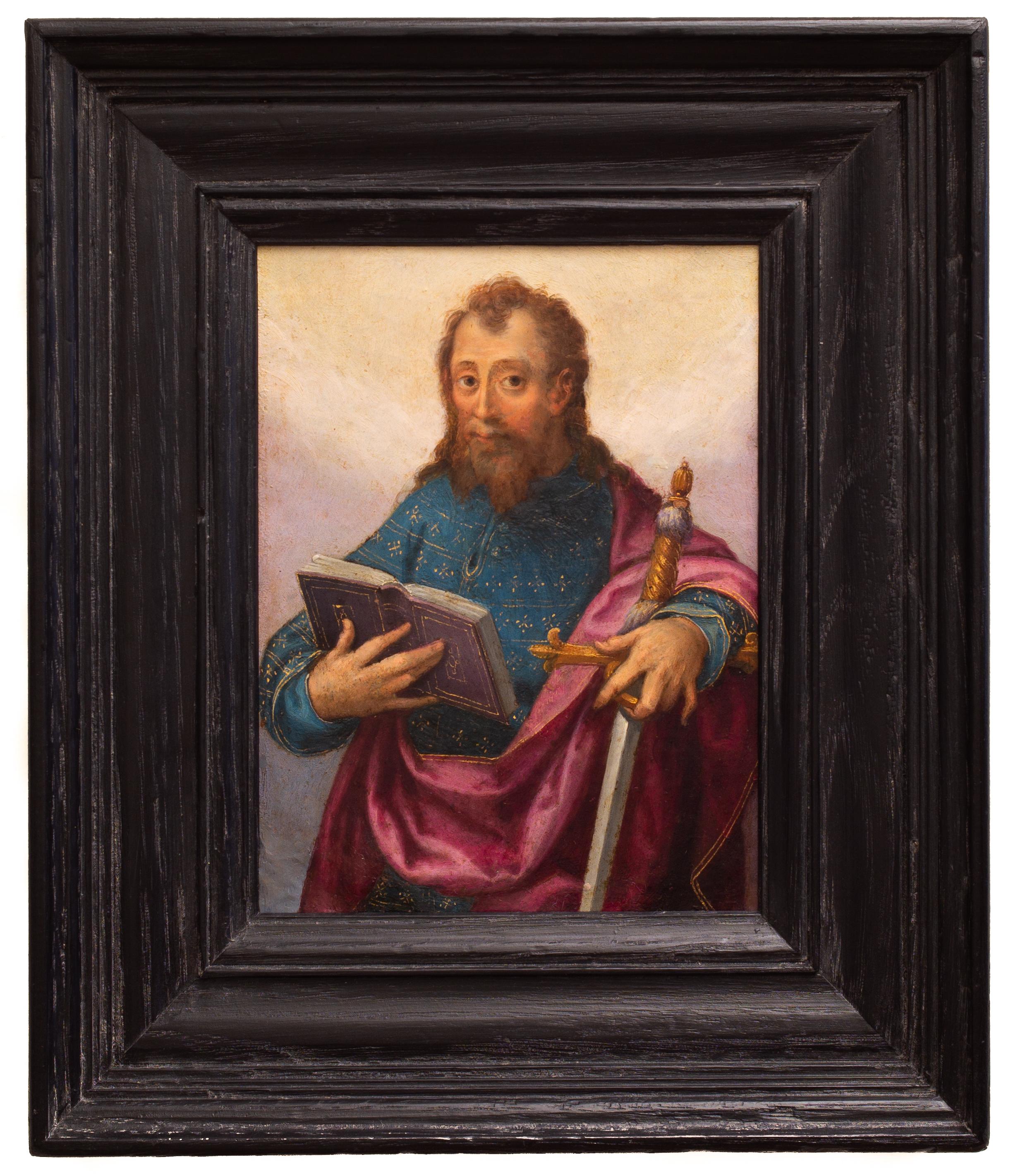Items Similar to Adoration of the Shepherds, attributed to Louis de Caullery, early 17th century
Want more images or videos?
Request additional images or videos from the seller
1 of 11
Adoration of the Shepherds, attributed to Louis de Caullery, early 17th centurycirca 1620
circa 1620
About the Item
Adoration of the Shepherds
Attributed to Louis de Caullery (1580-1622)
17th century Antwerp School, circa 1620
Oil on copper: h. 54 cm (21.26 in.), w. 72 cm (28.35 in)
A 17th century Louis XIV period giltwood frame carved with flowers, foliage and scrolls.
Framed: h. 69 cm (27.16 in), w. 87 cm (34.25 in.)
Illustrating an episode in the life of Christ, the adoration of the shepherds, our painting is part of a series of works associated with the birth of Jesus and is one of the few biblical subjects treated by the Antwerp painter, Louis de Caullery. Rather specialized in feasts and genre scenes, Louis de Caullery, following the example of his contemporaries, also devoted himself to sacred painting, favouring two opposing subjects in his body of work: the Nativity and the Crucifixion. Generally, he illustrates very few scenes from the Old Testament.
Our painting highlights the moment after Jesus' birth in the stable. The shepherds were the first to be informed of the event and arrived on the scene long before the Magi.
The painter places the Virgin Mary in the centre with a halo on her head, dressed in a blue cloak showing the improvised cradle of the baby Jesus, while an angel bows before him. The shepherds gather around the Virgin and Jesus, spread out on either side, some kneeling in veneration before Christ. The painter places Saint Joseph with the ox in the background among the spectators.
In heaven a whole assembly of cherubs sings a sacred concert proclaiming the birth of the Saviour. A celestial light pierces the darkened sky to illuminate the scene.
The harmony of the warm-toned colours is broken by the icy blue and green clothing of some figures, bringing contrasts to the composition.
The finesse of the brush in the rendering of the fabrics accentuates the folds of the wrinkled clothes and brings volume and depth. Admirably constructed, the composition is enriched by numerous figures on earth and in the heavens, by numerous superimposed planes.
Related works:
- Louis de Caullery's studio, Musée des Beaux Arts d'Orléans
- Louis de Caullery's studio, Musée Vivant Denon in Chalon-sur-Saône
- Louis de Caullery, signed and dated 1621, private collection, listed in the RKD database under the number 1001086704
- Attributed to:Louis de Caullery (1580 - 1621, Belgian, French)
- Creation Year:circa 1620
- Dimensions:Height: 27.16 in (68.99 cm)Width: 34.25 in (87 cm)
- Medium:
- Movement & Style:
- Period:Early 17th Century
- Condition:Very good original condition, cleaned and revarnished by our professionnal art restorer.
- Gallery Location:PARIS, FR
- Reference Number:1stDibs: LU2433213627582
About the Seller
No Reviews Yet
Vetted Seller
These experienced sellers undergo a comprehensive evaluation by our team of in-house experts.
1stDibs seller since 2023
- ShippingRetrieving quote...Ships From: PARIS, France
- Return PolicyA return for this item may be initiated within 3 days of delivery.
More From This SellerView All
- Allegory of Summer, workshop of Hendrick Van Balen 17th c. Antwerp schoolBy Hendrick van BalenLocated in PARIS, FRAllegory of summer, personified by Ceres Workshop of Hendrick Van Balen Antwerp School, early 17th century. Oil on copper, Dimensions: h. 52 cm, l. 40cm Antic giltwood frame Framed dimensions: h. 74 cm, l. 60cm Very good condition Our delicately painted work is part of the pictorial tradition that is both allegorical and mythological in vogue in Antwerp, whose leaders are Jan Brueghel the Younger and Hendrick Van Balen. Numerous works emerging from their workshops illustrate mythological subjects, the seasons, the elements, the senses or intertwining the lush landscapes, animals and gods of Olympus. At the heart of a green landscape dominated in its center by a generous apple tree, the beautiful Ceres, partially dressed in a large blue drape, is wearing a crown of ears of wheat, her symbol of the goddess of the earth and harvests. She holds the sickle in her right hand and carries sheaves of wheat. To her right a nymph holds the cornucopia while puttis pick and offer flowers. In the foreground are the summer fruits: figs, cherries, apples and lemons. A squirrel munching on cherries symbolizes toil and foresight, themes that are echoed in the work of the harvesters on the wheat fields in the background. The background is composed of vegetation, on the right a wild rose bush with its branches erect against a tree trunk, in the center of the trees with silvery green foliage. Our painter, a student of Hendrick Van Balen, finds his inspiration in the works of the master such as this nymph in yellow drapery seen from behind, one of the figures which accompanies many of the master's paintings. The elegant gestures, the flesh...The indisputable influence of Jan Brueghel the Younger is revealed in the treatment of trees and flowers, wild roses, tulips as well as in the still life with the squirrel in the foreground. The craze for this type of virtuoso painting where the mythological figures are only a pretext to better illustrate the landscape and plant species surrounding them, then generated orders from all over Europe. Hendrick Van Balen, Flemish painter, born and died in Antwerp (1575-1632). A student of Adam Van Noort, he entered the guild of Saint-Luc in 1593, later trained in Italy and was Van Dyck's first master. He often painted small characters taken from scenes from the Bible or classical mythology, on paintings in which Josse de Momper...Category
Early 17th Century Old Masters Figurative Paintings
MaterialsCopper
- The Triumph of the Infant Bacchus, workshop of H. Van Balen, 16th c. AntwerpBy Hendrick van BalenLocated in PARIS, FRThe Triumph of the Infant Bacchus, Workshop of Hendrick Van Balen (1575-1632) Antwerp, c.1630 Oil on copper, h. 28 cm (11.02 in), w. 35 cm (13.78 in) A large Roman 17th century golden painted frame Framed: h. 52 cm (20.47 in.), w. 58 cm (22.83 in) Our finely painted work depicts The Triumph of the Bacchus as a young boy and is one of the most popular mythological subjects in Antwerp at the beginning of the 17th century. Feasting, wine and fun are the themes that constantly appeal to the public. Thus unfolds before our eyes on our painting the procession composed of nymphs, baccantes, fauns, satyrs and children, their bodies naked, partially covered with brightly coloured draperies that help to brighten up the parade. Playing various instruments, dancing and drinking, while carrying vases and poles adorned with grapevines, participants to the rhythm of a noisy brass band make their way to an ancient temple standing on the right. The exaggerated gestures convey to us the frenzy of the excited crowd. The Child Bacchus follows the joyous procession, carried by satyrs and nymphs, crowned with ivy and joyfully raising a cup of wine. In the foreground, the drunken participants leave the procession, the children on the left and the group of bacchantes and satyrs on the right are resting among various objects scattered at their feet: cups, vases, ewers bear witness to the festivities in progress. In the background, a hilly landscape stretches out on the horizon, a semblance of calm that contrasts with the bustle of the foreground. The artist strives to multiply the many details, whether it be figures, costumes, flowers or vegetation, in order to demonstrate his know-how and the perfection of his execution. The acidulous palette with fresh and varied colours is characteristic of Hendrick Van Balen's works. There are several versions identical to ours with similar dimensions painted by Hendrick Van Balen and his workshop. Related works: • Koller Auction, Zurich, 21/09/2007, oil on copper, 28,5 x 37,4 cm. • Staatliche Kunsthalle, Karlsruhe, Inv. N° 809 (oil on copper, 40 x 53,5 cm) • Auktionshaus für Altertümer Glückselig, Vienne, 10/05/1932, ( oil on copper, 34 x 42 cm) • Gemäldegalerie of Pommersfelden, Schloss Weissenstein, oil on panel, 47 x 64 cm Hendrick Van Balen, Flemish painter, born and died in Antwerp (1575-1632). A pupil of Adam Van Noort, he entered the Guild of St. Luke in 1593, later trained in Italy and was Van Dyck's first teacher. He often painted small figures taken from scenes from the Bible or classical mythology, on paintings whose backgrounds and landscapes were painted by Josse de Momper...Category
17th Century Old Masters Figurative Paintings
MaterialsCopper
- 17th c. Flemish - Landscape with Flight to Egypt - Antwerp circa 1630Located in PARIS, FRLANDSCAPE WITH FLIGHT TO EGYPT, JASPER VAN DER LANEN (ANTWERP, 1585 - 1634) 17TH CENTURY FLEMISH SCHOOL ANTWERP CIRCA 1630 Oil on copper, dimensions: h. 10.23 in, w. 14.96 in Flemish style frame in ebonized wood adorned with wavy moldings and wood veneer. Framed dimensions: h. 17.32 in, w. 21.65 in Provenance: Philips auction...Category
Early 17th Century Old Masters Figurative Paintings
MaterialsCopper
- A 17th c. Italian school, Capriccio with the Colosseum, circle of V. CodazziLocated in PARIS, FRA capriccio with the Colosseum in Roma 17th century Italian school Circle of Viviano Codazzi (1604-1670) Oil on canvas Dimensions: h. 35.43 in, w. 51.18 in Modern 17th century style ...Category
17th Century Old Masters Landscape Paintings
MaterialsCanvas, Oil
- Late 17th century portrait of a French princess, daughter of Louis XIVBy Pierre GobertLocated in PARIS, FRPortrait of Françoise Marie de Bourbon, Duchess of Orléans as Venus A magnificent painting depicting the princess in all the splendour of her youth, Françoise Marie de Bourbon, known...Category
Late 17th Century Old Masters Figurative Paintings
MaterialsCanvas, Oil
- Virgin with child, workshop of Pieter Coecke Van Aelst, 16th c. Flemish schoolLocated in PARIS, FRVirgin and Child Workshop of Pieter Coecke Van Aelst (Aelst, 1502- Brussels, 1550) 16th century Oil on oak panel Dimensions: panel: h. 71.5cm, W. 48.5 cm (28.15 in x 19.09 in) Later ...Category
16th Century Old Masters Figurative Paintings
MaterialsOak, Oil
You May Also Like
- Stag Hunting in the Vicinity of Nuremberg by a German Artist Peter von BemmelLocated in PARIS, FRThis small landscape shows a hunting scene: two riders are chasing a stag with their dogs at the edge of a forest. Signed by Peter von Bemmel, it is typical of the production of this...Category
1720s Old Masters Landscape Paintings
MaterialsCopper
- Mary Magdalene - Faith transforms inner into outer beauty and conquers death -By Balthasar DennerLocated in Berlin, DEBalthasar Denner (1685 Hamburg - 1749 Rostock). Mary Magdalene. Oil on copper, 37 × 32 cm (visible size), 45 x 40 cm (frame), signed and indistinctly dated "Denner 17(...)" at centre...Category
1720s Old Masters Figurative Paintings
MaterialsCopper
- La Sagrada FamiliaLocated in Miami, FLJosé de Páez (1727-1790) Colonial Mexican painting from the 18th century. Conserved in excellent condition. "La Sagrada Familia" Oil on Copper 8 x 12 in ...Category
18th Century Old Masters Figurative Paintings
MaterialsCopper
- Flemish School, 17th Century, Mary MagdaleneLocated in Stockholm, SEFlemish School, 17th Century Mary Magdalene oil on copper 17th century plate dimensions 23 x 17 cm frame 27 x 22 cm Restored by professional art conservator 2022. Provenance: ...Category
17th Century Old Masters Figurative Paintings
MaterialsCopper
- A Wooded Landscape With Riders, Attributed to Pieter Gysels, Oil on CopperLocated in Stockholm, SEPieter Gysels, also known as Peeter Gijsels, was a renowned Flemish painter who lived from 1621 to 1690/91. He was known for his landscapes, which often depicted idyllic scenes from nature, and his works are highly sought after by Old Master collectors. We are proud to offer a newly discovered pair of landscapes attributed to him; this one called "A Wooded Landscape With Riders" This stunning painting captures the beauty of a serene summer day in the countryside. In the foreground, we see a couple riding on horsebacks, enjoying the peaceful surroundings. The horses seems to be trotting gently, and the riders are relaxed, taking in the natural splendour around them. In the distance, we see several other figures, perhaps farmers or peasants, doing their daily tasks. We also see a small stream flowing through the landscape, with several small houses. And in the background, we see a beautiful wooded area with tall trees reaching up towards the sky. The attention to detail in this painting is truly remarkable. Gysels use of vibrant colours evoke the warmth and beauty and he skillfully captured the play of light on the landscape, creating a sense of depth and atmosphere. The detailing of the cottages, the colors, the use of big-leafed plants in the foreground, and the figure types are typical of his signature style. "A Wooded Landscape With Riders" is painted on copper, which gives the painting a unique luminosity and depth. The use of copper as a support for paintings was popular in the seventeenth century. We also have one more painting called "Wooded Landscape With an Elegant Company...Category
17th Century Old Masters Figurative Paintings
MaterialsCopper
- St Paul With Sword and Book, Mannerist School, Oil on CopperLocated in Stockholm, SEMannerism, derived from the Italian term "maneria," which simply means "style," was an artistic movement that emerged in the later years of the Italian High Renaissance, around 1520, and extended into the early 17th century. It is often referred to as the "stylish style" due to its emphasis on self-conscious artifice rather than realistic depiction. Historians debate whether Mannerism should be classified as a style, a movement, or a period. In contrast to the harmonious ideals embraced by renowned artists such as Raphael, Michelangelo, and Leonardo da Vinci, Mannerist painters took a step further and created compositions that were almost bizarre. They introduced fresh color schemes, elongated proportions, and exaggerated anatomy of figures, portraying them in convoluted and serpentine poses. These artists skillfully exhibited their techniques and abilities, aiming to evoke a sense of sophisticated elegance. Among the notable Mannerist painters are Jacopo da Pontormo, Bronzino, Lavinia Fontana...Category
17th Century Old Masters Figurative Paintings
MaterialsCopper
Recently Viewed
View AllMore Ways To Browse
Pin Up Board
Modern Italian Pop Art
Jan Cybis
Hai Pink
Orange Beach Alabama Painting
Leroy Neiman Book
University Of Strathclyde
Chiamaka Praise
Used Paino
Painting Signed Admiral
Native American Girl Portrait
Used Painos
Aaron Abraham Shikler
Al Buell
Green Painting Portrait
La Fete De Paris
Lobo Bronze
Simon Gunning





